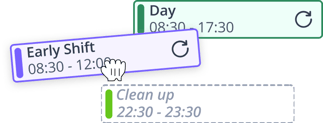Paid breaks, split shifts, on-call, first-and-last journeys; what actually counts as “working time” under UK rules? If you get this wrong, you risk breaching the 48-hour limit, missing daily rest, and triggering back-pay or NMW issues. Many SMEs stumble on edge cases: a break that’s interrupted, a sleep-in at the workplace, or travel between clients. This guide gives clear answers for employers and managers.
Do paid tea or lunch breaks count as working time?
Short answer: No; a tea or lunch break is not working time unless it’s interrupted or the worker must stay available; whether it’s paid is a contract choice.
What the law says about breaks
Workers who work more than 6 hours are entitled to one uninterrupted 20-minute rest break. “The break doesn’t have to be paid; it depends on their employment contract.” Daily (11 hours) and weekly rest entitlements sit alongside this rule.
Only working time counts toward the 48-hour average and rest calculations. If breaks are true rest (even if paid), they do not count as working time.
When a ‘break’ becomes working time
A “break” counts as working time if the worker must work, stay on call/available, or is otherwise at your disposal. For example, answering phones, staying at the desk, or having the break repeatedly interrupted. ACAS says rest breaks should be uninterrupted, away from where they work, and there’s no entitlement to pay unless agreed in the contract.
Quick table:
| Situation | Working time? | Reason |
|---|---|---|
| 20-minute uninterrupted break away from work | No | It’s rest, not work. |
| Break interrupted to serve customers | Yes (interrupted part) | Worker is at employer’s disposal. |
| “Break” at desk while monitoring phones | Likely yes | Not away from work; not uninterrupted. |
Policy tip
-
Say plainly in contracts/handbooks whether breaks are paid or unpaid
-
Log interruptions and give compensatory rest if rest is missed.
-
Record start/end of breaks for clean working time UK audits.
How do split shifts affect what counts as working time?
With split shifts, gaps between work blocks are not working time if the worker is genuinely free and not required to remain on-site or on standby. Where shifts or patterns cause missed rest, compensatory rest should be offered. ACAS gives examples of split-shift patterns and confirms the same rest rights apply, including making up missed rest.
Split-shift checklist:
-
The gap is true rest (no required presence, no on-call obligations).
-
If operational needs cut rest, document and grant compensatory rest.
-
Record start/finish of both blocks to separate working time from the unpaid interval.
Respecting the 11-hour daily rest (daily rest 11 hours UK)
Workers must get 11 hours’ rest between finishing work and starting again. Two blocks that straddle midnight can breach this if the finish and next start are too close (for example, finish 23:00, start 07:00 = only 8 hours).sets out the 11-hour rule and weekly rest entitlements alongside it.
Rota design checklist (avoid ‘hidden’ on-call constraints)
-
Confirm the gap is genuine rest: no obligation to stay on the premises; free to use time as they wish.
-
Avoid “soft standby”: if you require proximity, tight response times, or restrict movement, you risk the gap counting as working time.
-
Protect daily/weekly rest: check 11-hour daily rest and weekly rest (24 hours weekly or 48 hours fortnightly).
-
Plan compensatory rest where patterns make standard rest impractical; document it.
Does time ‘on-call’ or ‘standby’ count as working time?
The more control you place on activity, location or response time, the more likely on-call time is working time. ACAS says on-call does not usually count if the worker is away from the workplace and “can spend the time in any way they choose”. It’s more likely to count the more you control their activities, location or time.
📝 Practical test:
-
Can they use the time freely? If yes, it’s probably rest. If no, it leans working time.
-
Are there tight response targets or location limits? That points to working time.
-
Any time actually spent doing tasks while on call always counts.
When does travel time count as working time?
What mobile/peripatetic roles need to know about first and last journeys.
Tyco principle (no fixed workplace)
For workers with no fixed or usual workplace (peripatetic roles), the first journey from home to the first job and the last journey home count as working time. This is the Tyco ruling, applied widely in UK guidance for mobile workers. It affects working time calculations (48-hour average, daily/weekly rest), not an automatic right to extra pay.
At-a-glance
| Worker type | First/last journey counts for WTR? | Notes |
|---|---|---|
| Mobile worker with no fixed base | Yes | “At the employer’s disposal” while routing to customers. |
| Office-based with fixed workplace | No (usually) | Standard commuting doesn’t count. |
Pay vs working time (national minimum wage travel time)
Working time for limits is not the same as payable time. For NMW, HMRC’s manual says home-to-work travel is not time worked, but travel between assignments or to training usually is. This means your remuneration rules must map to these definitions, especially for care and field roles.
Manager actions:
-
Pay NMW for travel between clients and training travel.
-
Do not count standard home-to-work travel for NMW, even if Tyco makes it working time for WTR.
Who this applies to (examples)
Tyco mainly hits mobile workers: care workers, field engineers/trades, travelling sales and teachers working across multiple sites. Standard commuters with a fixed workplace are not covered.
Are sleep-in shifts paid and do they count as working time?
For WTR, sleep-ins usually count as working time if the worker must stay on site. For pay, the UK Supreme Court (Mencap, [2021] UKSC 8) confirmed workers on sleep-ins are entitled to NMW only for hours when they are awake and working, not for time spent permitted to sleep.
Simple rule:
-
Count sleep-in shifts for working time limits and rest planning.
-
Pay NMW for awake work during the sleep-in; not for the sleeping period itself.
Record what was ‘awake work’
Keep clean evidence for NMW and audits:
-
Timestamp start/stop of each disturbance.
-
Note the reason and tasks carried out.
-
Attach any call logs or incident notes.
-
Export totals by pay reference period to prove average NMW compliance.
Sector note (care, hospitality, security)
Common approaches:
-
Care: flat sleep-in allowance plus NMW for awake minutes, with rota guards to protect compensatory rest after busy nights.
-
Hospitality/security: “sleep-over” cover often treated as working time for WTR with awake-only pay; contracts must be explicit and training must cover when to clock “awake.”
How do daily and weekly rest rules apply to split shifts?
Under the working time regulations UK, adults are entitled to:
-
20-minute rest break if working over 6 hours,
-
11 hours’ daily rest between finishing and starting work,
-
24 hours’ weekly rest (or 48 hours per fortnight).
ACAS confirms the same rights apply to split shifts, and where rest is missed, compensatory rest should be given. Keep health, safety, and fatigue risks in mind when designing patterns.
Compensatory rest on atypical patterns
If a split shift, emergency, or late change prevents a worker taking their 20-minute break, 11-hour daily rest, or weekly rest, offer equivalent rest as soon as possible and document it. ACAS’s guidance on “missed rest and compensatory rest” is clear that split-shift workers have the same right to make up missed rest.
How to apply it (step-by-step)
- Identify the shortfall (e.g., only 8 hours between blocks).
- Schedule the replacement rest (length broadly equivalent).
- Record the reason and date given.
- Monitor recurrence and adjust rotas.
Scheduling pitfalls (back-to-back blocks undermining 11h; rota examples)
Common issues with split shifts:
-
Blocks straddling midnight (e.g., 18:00–23:30 and 07:00–11:00 next day = only 7.5 hours’ daily rest). This risks non-compliance with the 11-hour daily rest.
-
Hidden on-call constraints during the “gap” reduce it from rest to working time if you set tight response rules or restrict movement. Plan true rest between blocks.
-
Missed weekly rest when patterns repeat—use the 24 hours weekly / 48 hours fortnightly check.
‼️ Rota rule of thumb: finish time + 11h ≤ next start. If not achievable, grant and log compensatory rest.
What should we record to prove compliance (and avoid back-pay)?
Record the who/what/when for each working time event:
-
Shift start/finish and break start/finish (mark interruptions).
-
On-call/standby start/stop and any minutes actually worked.
-
Mobile worker travel: first journey to first job and last journey home (for WTR calculations), plus between-client travel.
-
Sleep-in: total sleep-in window and any awake work during disturbances.
⚠️ UK law requires employers to keep adequate records to show compliance with the 48-hour average, night work limits, and related requirements, and retain them for 2 years; the format is up to you.
Flag exceptions
Create a simple exceptions log so auditors can see risks were managed:
-
Missed rest → compensatory rest given (date, duration, reason).
-
Sleep-in ‘awake minutes’ with timestamps and notes (for NMW and WTR).
-
Travel between clients captured separately from standard commuting (for NMW).

- Easily clock in and out
- Automatic calculation of surcharges
- Link with payroll administration

How Shiftbase helps with working time compliance
If you’re juggling split shifts, on-call rules, and travel time, clean data and clear rules are what keep you safe. Shiftbase brings your rota, hours, and evidence together so you can prove what counted as working time and why.
What you can automate:
-
Employee scheduling: rota templates with daily/weekly rest guards, split-shift gaps, and alerts for 11-hour breaches.
-
Time tracking: break flags (paid/unpaid), interruption logs, on-call/sleep-in shift types, first/last-journey capture for mobile workers.
-
Absence management: compensatory rest entries tied to shifts and exported alongside timesheets.
-
Compliance exports: separate WTR-counting hours from NMW-payable time for quick audits and payroll checks.
Ready to simplify working time, breaks, and split-shift evidence? Start your free 14-day trial and see how Shiftbase keeps you compliant without the spreadsheets.
Frequently Asked Questions
-
No. Breaks don’t have to be paid and usually aren’t working time, unless the worker must work or stay available.
-
Only if the worker must remain at the employer’s disposal (for example, on-site or tightly on-call). Otherwise, they’re rest.
-
For mobile workers with no fixed workplace, yes; the first and last journeys are working time (Tyco). Pay is a separate question.
-
No. NMW applies only when awake for the purposes of working
-
Adults must get a 20-minute break if working >6 hours, 11 hours’ daily rest, and 24 hrs weekly (or 48 hrs fortnightly).
-
Count the time spent working as working time and give compensatory rest later; log it.


